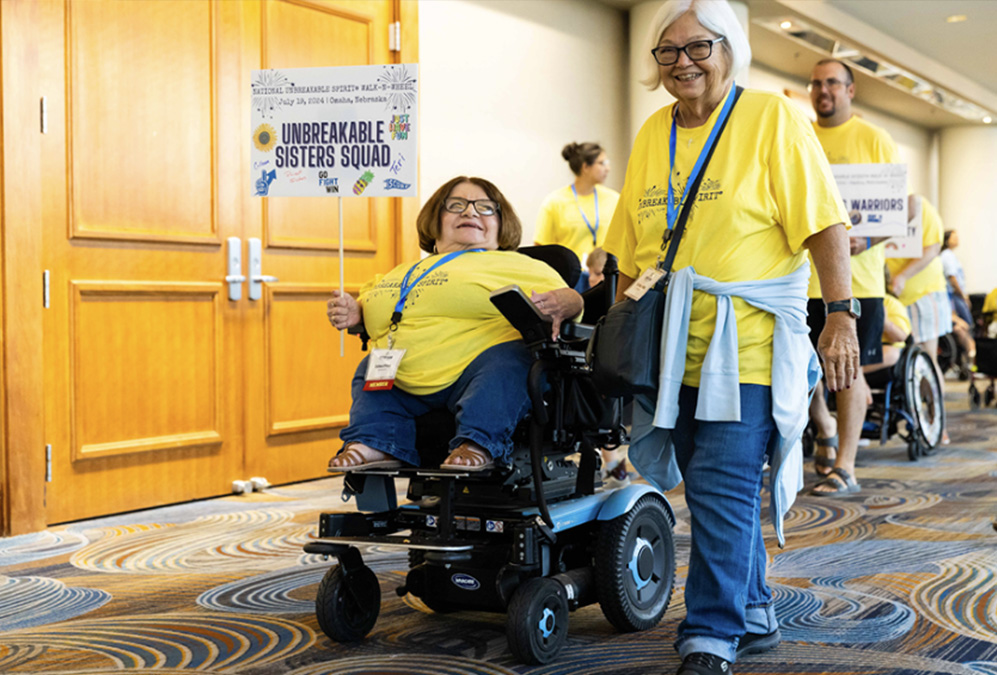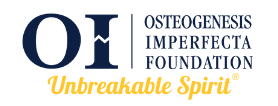Treatment

SHARE
Treatment
There is no cure for OI, but there are ways to manage the symptoms. Despite the obstacles, many people who have OI lead productive and fulfilling lives well into their adult years. The goal of treatment is to minimize fractures, enhance independent function, and promote general health.
Medical Team
Medical care for both children and adults who have OI involves an interdisciplinary team. This can include: a primary care doctor, orthopedists, endocrinologists, geneticists, rehabilitation specialists, neurologists, and pulmonologists. Treatment from these specialists may include fracture care, physical therapy, surgical procedures, medications, lifestyle features, and mobility aides.
- Fracture Care: casting, splinting, and bracing broken bones can help them heal properly. However, long periods of immobility can further weaken bones and lead to muscle loss, weakness, and more fractures. Many orthopedists prefer to treat fractures with short-term immobilization in lightweight casts, splints, or braces to allow some movement as soon as possible after the fracture.
- Physical Therapy and Safe Exercise: Goals for physical therapy include expanding and maintaining functioning and promoting independence. A typical program includes muscle strengthening and aerobic conditioning. Physical therapy often begins in infancy to counteract the delay in motor skill development many children experience due to OI related muscle weakness. Adaptive devices may be needed.
- Occupational therapy can help with fine motor skills and selection of adaptive equipment for daily living. As a child with OI grows older and gains more independence, he or she will benefit from continued physical activity. Adults with OI also benefit from safe and regular exercise to maintain bone and muscle mass. Swimming and water therapy are particularly well-suited for people with OI of all ages, as they allow independent movement with little fracture risk. Walking is also excellent exercise for those who are able (with or without mobility aids).
- Surgery: Surgery may be needed to repair a broken bone, correct bone deformities such as bowing, stabilize the spine, or repair tiny bones in the middle ear and improve hearing. Many children with OI undergo a surgical procedure known as rodding- in which metal rods are inserted into the long bones to control fractures and improve deformities that interfere with function. Both non-expandable and expandable rods are available.
- Medication: Currently, there is no cure for OI. However, there are a variety of treatment options that your doctor may recommend. Bone mass in OI is impacted by the balance between bone resorption and bone formation. When bone resorption exceeds bone formation, bone density and bone strength decline. This imbalance can be counteractive through either Antiresorptive therapies (decreases the rate of bone resorption) or Anabolic therapies (increases the rate of bone formation).
Bisphosphonate drugs, which are currently approved by the Food and Drug Administration (FDA) to prevent and treat osteoporosis, are used off-label to increase bone density in children and adults with OI. Other drugs developed to treat osteoporosis are used to improve bone mineral density (BMD) in adults who have OI. These include Parathyroid hormone analogues (Forteo and Tymlos). Osteoporosis treatments like RANKL inhibitor (Denosumab) and Anti-Sclerostin antibody (Evenity) are of interest but there’s little information about them yet in OI. Treatments under study include the development of new medications specific to OI, growth hormones, stem cell transplantation, and gene therapies. For more information about current clinical trials on drug therapies in OI, visit www.oif.org/currentstudies. - Healthy Lifestyle: People with OI benefit from a healthy lifestyle that includes safe exercise and a nutritious diet. Adequate intake of nutrients, such as Vitamin D and calcium, are necessary to maintain bone health. However, extra-large doses of these nutrients are not recommended.
Maintaining a healthy weight is important since extra weight adds stress to the skeleton, heart, and lungs and reduces the ability to move easily. In addition, people with OI should avoid smoking, second hand smoke, excessive alcohol or caffeine consumption, and steroid medications, all of which reduce bone density. - Other treatments that focus on OI-related symptoms include: hearing aids, crowns for brittle teeth, supplemental oxygen for people with breathing problems, and mobility aids.
References
- Sutton VR. Differential Diagnosis of Osteogenesis Imperfecta in Children (253-266). In Shapiro JR. (Ed.). (2014). Osteogenesis Imperfecta: A Translational Approach to Brittle Bone Disease 1st edition. New York, NY: Elsevier Academic Press.
- Bober MB (Ed.). (2013). Introduction to Osteogenesis Imperfecta: A Guide for Medical Professionals, Individuals and Families Affected by OI. Gaithersburg, MD: Osteogenesis Imperfecta Foundation.
- Website- Information about and resources for genetic testing may be found on GeneTests (www.genetests.org) or the GTR: Genetic Testing Registry (http://www.ncbi.nlm.nih.gov/gtr/).
Related OIF Podcast Episodes
Treatment Implications in Genetic Heterogeneity in OI
Physical and Occupational Therapeutic Strategies for Adults with OI
Physical and Occupational Therapeutic Strategies for Children with OI
Helping our community stay up to date and connected.
Please sign up to receive updates from the OI Foundation including our monthly e-Newsletter, research updates, and upcoming event information.

